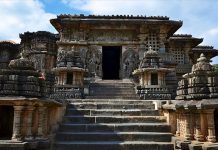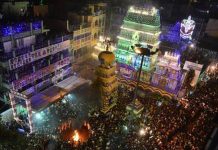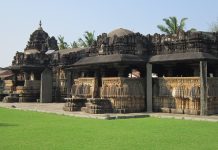The Mutt is dedicated to the holy scholar Sri Yogi Narayan, who was born in 1726 in Kaiwara. In his 110 years of blessed existence, Yogi Narayan, or Thataiah, as he is called, played the important role of spiritual leader and social reformer.
Thataiya belonged to a line of seers from the Vedic and Upanishadic period. All his teachings are based on the Upanishads, Ramayana, Mahabharata and Bhagavad Gita. He preached the essence of devotion, taking examples from Bhagwat. He also followed the Narada Bhakti Sutras.
Thataiya was the identity of a true and mystic yogi. Many examples of yoga can be found
Experiences in his works, all of which were influenced by his own experiences. He mocked the caste discrimination prevalent in society and found similar life values in Sri Ramanuja’s preaching of Vishishtadvaita. He also liked the vyshnava agama form of worship in temples and advised others to adopt it as well. This form of temple worship is still practiced in the Mutt’s temple.
Like Sri Ramanuja, he said that salvation is open to all without discrimination based on caste, creed, and gender. He was a highly enlightened yogi who believed that the path of yoga is the only path to salvation under the guidance of a true teacher.
Early Life
Sri Yogi Narayan was born in 1726 in Kaiwara, the son of Kandavappa and Mudadamma, a couple from the Telugu-speaking community “Banajiga”. Sri. Narayan’s father Kondappa was a traditional bangle seller and his mother was a housewife. The birth of his son after many years of hardships was, for the couple, the answer to their most ardent prayers and a true blessing from the Almighty. In gratitude, they chose to name him “Narayana”, also known by the same name, in honour of Lord Vishnu.
Growing up, Sri Narayana was very different from other children of his age. They often found him sitting in the depths Meditation in the temples of Sri Amar Narayana and Sri Bhimalingeshwar. His interest in Bhajans, Puranas and Kirtans were surprising to a boy of his age.
Although He was quite serious and introspective by nature, Sri Narayana loved folk entertainment such as dancing and street performances. In particular, he derived great pleasure from the Hari and Shiva stories, from the life of Lord Vishnu, from music and songs. These stories not only gave valuable lessons, which left a lasting impression on Sri Narayana, but also ignited his religiosity.
Married Life
A few years after his son’s marriage, old age and illness caught Kondappa and Mudadamma, and Sri Narayana lost both parents in quick succession. Overcome with destruction and shock, he once again turned to the Almighty, and sought solitude and comfort in the temple of Sri Amar Narayana. Through prayer and meditation, he found himself and learned to heal the wounds of his loss.
Muniyamma, who was pregnant by then, gradually reminded Sri Narayana of his duties to his family and inspired him to adopt the family business of selling bangles. Sri Narayana accepted and renewed the responsibility, assuming his new role as provider.
However, Sri Narayana was a man of God.his trusting nature and his unshakeable belief that whatever happened was ordained by the Almighty, resulted in many individuals cheating him out of his legitimate earnings. The declining income put considerable pressure on His growing family, and what was once a small rift in her marriage soon became a large gap between husband and wife.
The hours spent in the Sri Amara Narayana temple helped Sri Narayan cope with the resentment at home and made him feel at peace.
Over time Sri Narayana became the father of three children: Pedda Kondappa, Chinna Kondappa and Mudadamma, all named their parents.
Turning Point
After leaving his home, Sri Narayana found himself on the outskirts of Kaiwara, near Vaikuntha Guhe or cave. He sat here in deep contemplation thinking about his future. He had no home to speak, no means of subsistence, no clarity on the road. In growing fear and despair, he called the Almighty, asking for his divine blessings.
For example, in response to his prayer, a cowherd introduced himself and asked him what was ailing him: “I’m a vet and I have the solution to all your ailments. What is it that troubles you?”
Sri Narayana narrated his concerns to the pastor, who calmly replied: “The Creator of the world, the Almighty, resides within you. If you are able to understand who you are, then you will understand that you are also an avatar of divinity.”
With these mysterious words of advice, that cowherd suddenly disappeared when he arrived.
The pastor’s significant words of advice quickly resolved Mr. Narayan’s wandering thoughts and gave him a sense of calm. The irrefutable truth of the cowherd’s advice, his timely presence and his unexplained disappearance convinced Sri Narayana that the Almighty Himself had come to receive him in the guise of a cowherd.
After this experience, Sri Narayana adopted the Almighty as his Guru. He addressed his beloved deity Sri Amar Narayana and requested to use his name as a mantra-name meditation for the blessings of the Almighty, a name whose repetition would help him achieve salvation.
The Tapas
Sri Naraeyana’s tapas or meditation lasted nine whole months, and went through several stages of evolution. From the sagunaradhana (worship of the physical manifestation of the Almighty) stage to the Nirugunaradhana (worship of the Almighty without form) stage, and from the Bahirmukha (looking beyond the self) stage to the antarmukha (looking within oneself) stage, Sri Naraeyana persevered all through.
Jeeva Samadhi

Until the 1830s, although his soul continued to inspire followers with his excessive enthusiasm, his body weakened with old age. Around this time, Thataiah decided to depart the world of life on the date and time of his selection.
The fateful day dawned and Thataiya’s followers from around the country flocked to his ashram. They watched in rapt attention as a bright-eyed Thataiya delivered his final sermon.
Thataiah began advising devotees not to get caught up in the illusion of the material world and urged them to view all the joys, difficulties and sorrows of life in the same way.
The birth of a human being, he said, is a great blessing. However, the sole purpose of life must be moksha or enlightenment. This can be accomplished by developing a deep understanding of Brahm Gyan or the Supreme reality. That knowledge, Thattaiah advised, can only be achieved through the service and devotion of a guru. Under the guidance of the Guru, and using the meditation tools, a person can attain enlightenment.
Thus, at midnight on the third day of the month of Jyestha in the lunar year of Sri Durmukhi (1836-1837), Thataiah left the mortal world.
Today, the inner temple shrine at Sri Yogi Narayan Mutt is located at the saint’s last resting place.
Other attractions in and around Kaiwara
Vaikunta, zoo and a national park, Vasavi temple, Kailasagiri cave temples and Alamgiri Venkateshwara.
How Reach Yogi Narayana Temple
Distance between Bangalore to Kaiwara is 61 KM; you my choose to ride – drive or even hire a cab. You may also choose to take a bus to Kaiwara.




























































